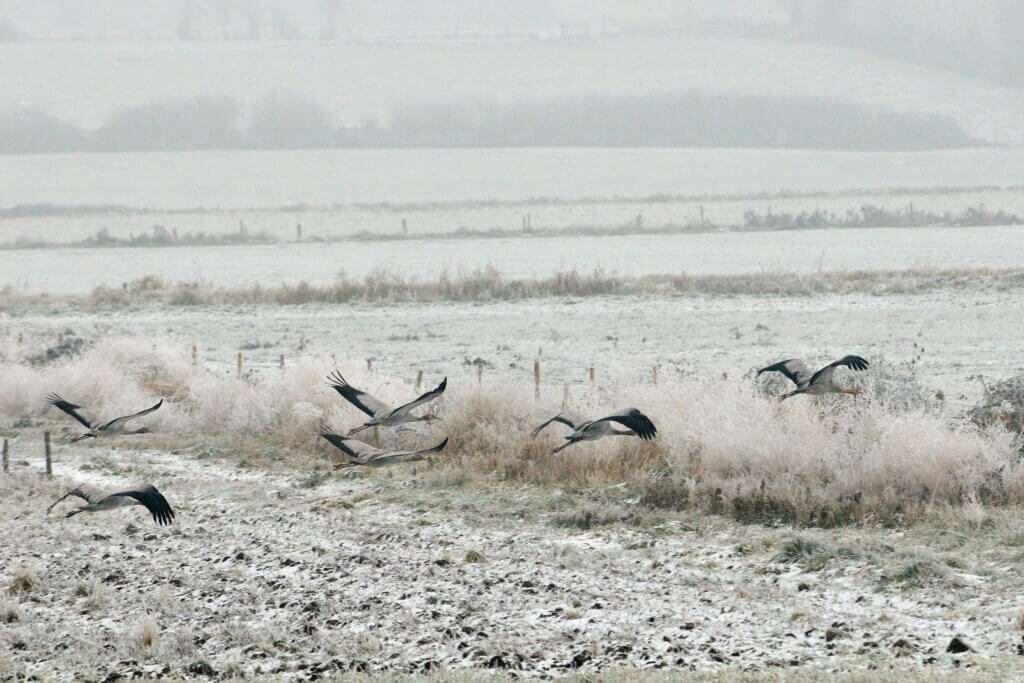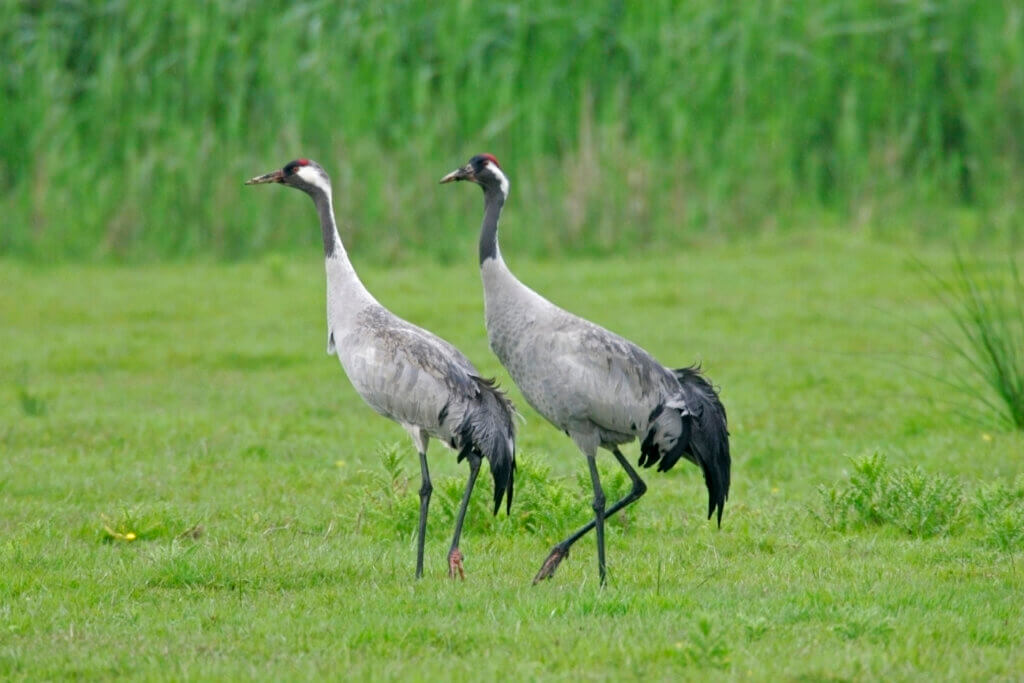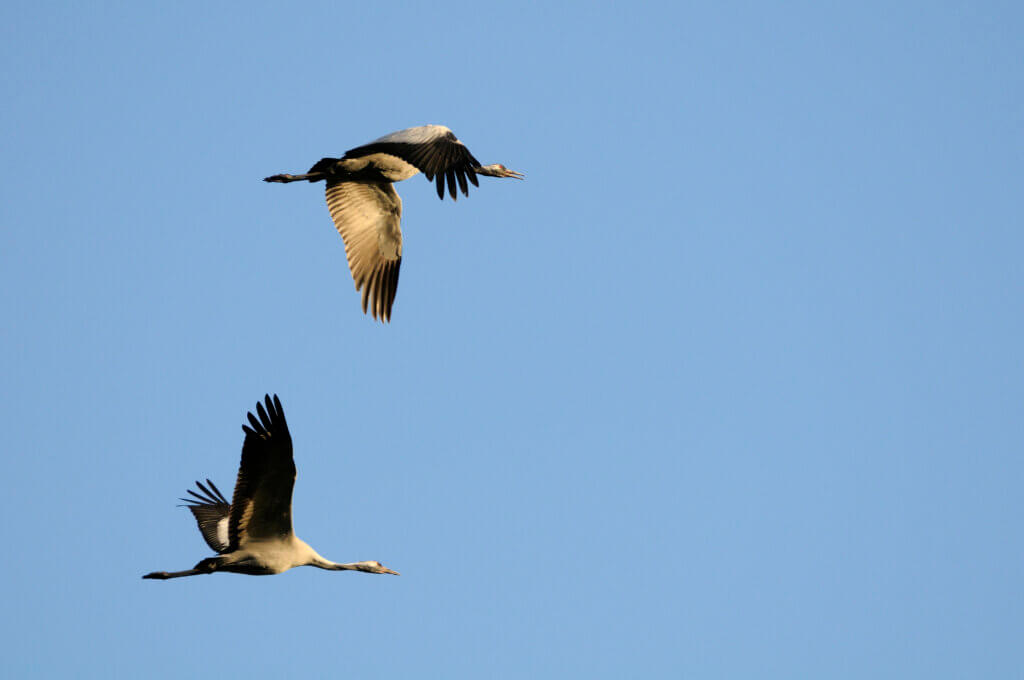UK crane population hits record high

- The latest common crane survey reveals a record-breaking 64 pairs of cranes in 2020, bringing the total population to over 200 birds.
- Cranes became extinct in the UK around four hundred years ago but following the natural recolonisation of a few birds and extensive conservation work, including a reintroduction programme, these amazing birds are making a return.
- Cranes are the tallest bird in the UK, standing at 4ft. They are fabled for their dances; complex displays with bows, pirouettes and bobs, which take place every year between the male and female.
Crane numbers have hit record levels after becoming extinct in the UK nearly 400 years ago. Thanks to the efforts of conservationists 64 pairs were present in 2020.

These birds, the UK’s tallest at 4ft, used to be quite common but a combination of hunting and wetland decline led to their extinction in the 1600s.
In 1979, a small number of wild cranes returned to Norfolk and conservation groups have been working together to encourage more and more of these birds. They have now spread to other areas of the UK, benefiting from improved habitat such as at the RSPB’s Lakenheath and Nene Washes reserves. Over half of all the cranes fledged in the UK since 1980 have fledged since 2015 – so the last five years have been incredibly productive.
In 2010, the Great Crane Project – a partnership between the RSPB, WWT and the Pensthorpe Conservation Trust, and funded by Viridor Credits Environmental Company – began creating and improving existing habitat, as well as hand-rearing young birds for release on the Somerset Levels and Moors.
All the conservation effort on peatland restoration and wetland protection has yielded impressive results, with 64 pairs across the UK last year, producing 23 chicks. Nature reserves have played a vital role. At least 85% of the breeding population are found on protected sites, with a third on RSPB reserves alone. The total population is now believed to be over 200 birds – a new record.
Damon Bridge, Chair of the UK Crane Working Group said: “The return of cranes to the British landscape shows just how resilient nature can be when given the chance. If we want to see this success continue then these sites that cranes use and need must get adequate protection.”.
Andrew Stanbury, RSPB Conservation Scientist said “Thanks to the dedication of individuals, the UK Crane Working Group and conservation organisations, we are delighted to see crane numbers continuing to grow. Government has already highlighted cranes as one of a number of species which have yet to receive strong protection for the areas they make their home. If we want to see this amazing achievement repeated across the UK, Governments must take action to designate the most important sites for this iconic species as part of the UK’s protected area network.”.
John Blackburn, from the Norfolk Wildlife Trust said “This is a result of the improvements and expansion of important wetland sites. The Norfolk Wildlife Trust is proud that our Broadland reserves, are not only the cradle of our growing crane population, but still their favoured stronghold, and is testimony to NWT’s staffs’ commitment.”
Stephen Prowse, from the National Trust said: “This is a significant milestone for cranes in the UK. The first wild breeding pair since the reign of Henry VIII was recorded on National Trust land in the Norfolk Broads. Careful protection has allowed their spread to surrounding counties, with a significant breeding population now located in the Broads. With a focus towards more habitat creation in the future, we hope to see the fortunes of these amazing birds continue to improve”.
February 2nd marks World Wetlands Day, with the focus this year being on wetlands and water. Wetlands provide protection from floods and storms with each acre of wetland absorbing up to 1.5 million gallons of floodwater. These important places not only help regulate the climate – peatlands store twice as much carbon as forests, with saltmarshes, mangroves and seagrass beds also holding vast amounts of carbon – but also provide a home for thousands of species including cranes.

ENDS
[registration_form]
That’s excellent news and great credit to the RSPB, WWT, and Pensthorpe Conservation Trust. A great team and a great result.
A great conservation story and credit to all those involved.
“If we want to see this amazing achievement repeated across the UK, Governments must take action to designate the most important sites for this iconic species as part of the UK’s protected area network.”
This is a non-sequiter.
The improvement in, and expansion of habitats for cranes is as a result of sympathetic management and I’d guess natural expansion. I don’t really see how notifying existing sites will repeat this amazing achievement.
What might help is advocating change in land management practice, which I’m sure the bodies involved are doing as well but nature has been failed by protected area policy which has led to the creation of small islands of joy in a desert of uniformity across the farmed landscape.
It’s far to easy for government to use notification of new protected areas as indicators of positive action, rather than introducing change that would benefit the wider countryside.
He might have expressed himself a little more clearly but it is surely not unreasonable to demand that areas used by cranes should receive strong levels of protection where this is not already the case. Failure to do so could see the expansion stall or reverse. As you suggest in your comment, doing this does not preclude making changes to land management practices in the wider countryside, which I would agree is likely to be key to the species becoming more widespread.
Thanks Jonathan. I actually thought Andrew Stanbury expressed himself very clearly, I’m just sorry that he and RSPB went for the bureaucratic approach rather than the positive land management “these birds could be much more widespread with the right incentives to land and water managers” angle.
Notification/designation in my understanding only prevents land managers from doing something new that is harmful, it cannot as far as I know compel them to do something unless the conservation agency goes through the long and complicated LAnd Management Order approach. I think this goes some way to explain why many of our so called protected areas are in such a parlous state. There are anecdotes of land managers ceasing positive works because they are feared of land being ‘sterilized’ through notification as, for example, an SSSI.
I guess my point is the old wider countryside versus protected areas debate and there’s not much to be gained in going over that again here.
I certainly agree with you about the need to promote/prescribe positive management measures across the wider countryside if we wish to see wildlife – not just cranes – flourish. I am painfully aware that SSSIs and nature reserves are often isolated islands surrounded by large expanses of wildlife depauperate farmland.